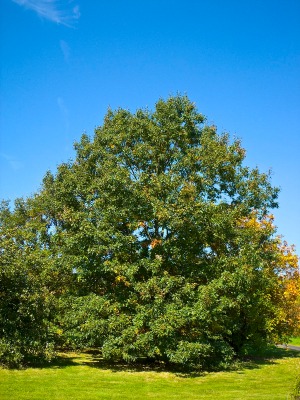
The survival of some species of oaks, among them black oak, have been threatened as forested areas in North America are cleared for agriculture, urban development, and other forms of development. It is a major goal of many forest managers to maintain current populations of oak (Quercus spp.) for timber, wildlife, and conservation biology. Currently, black oak is distributed throughout the eastern half of the United States.
From observations and modeling systems, it is postulated that:
- Black oak will have an opportunity to bounce back and increase in numbers as the climate changes.
- Optimal precipitation, suitable soil types, lack of plant competition, and occasional fires will enhance the survival rates of black oaks in some places.
-
Black oak populations will need to gradually shift northward and up into higher elevations to adapt to climate change.
Background on Black Oak
Black oak (Quercus velutina Lam) is a common, medium-sized to large oak in the Eastern and Midwestern United States. Although black oak grows best on moist, rich, well-drained soils, it is often found on poor, dry sandy soils, where it grows for up to two hundred years. Black oak provides acorns, which are an important source of forage for wildlife such as bears, squirrels, deer, and woodpeckers. They were an important of part of Native American diets.
The range of oak savannas in the Midwest have decreased dramatically due to a number of human-caused factors. Fire suppression in the region limited oak regeneration and facilitated the transition of many oak savannas to closed-canopy stands (Peterson and Reich 2001). These alterations to oak savannas make them a priority for restoration and conservation efforts in the Midwest.
Before European settlement, oak savanna covered more than 20 million acres. By 1985, 113 sites containing black oaks remained in the Midwest (Nuzzo 1986, Nature Conservancy 2011). The Kankakee Sands Conservation site on the northern Indiana/Illinois border is an ecosystem that is administered by the Nature Conservancy (Iverson et al. 2009). Spanning about 23,000 acres, the site offers a mix of meadows, prairies and black oak stands, which have survived in undisturbed areas. The main goal of the Kankakee Sands Conservation site is to preserve one of the best examples of a black oak sand savanna in the Midwest (The Nature Conservancy 2011).
A pressing question for natural resource managers and conservationists in the region centers around how climate change will impact black oak survival. There will be a significant change in Midwest climate, which will include rising average temperatures, longer growing seasons, shorter winters, and more severe storms, floods, and droughts. To help managers plan and understand expected changes in black oak populations in the Midwestern United States, researchers looked at several climate change models to evaluate likely temperature, soil, and precipitation conditions for the region in the coming future.
Black Oak and Fire
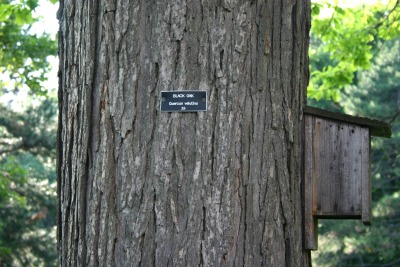
Oaks and other hardwoods are declining in the United States, in part because of land development and fire suppression. Oak savanna ecosystems in the Midwest are among those most threatened (Considine 2009, Nuzzo 1986, The Nature Conservancy 2011). Oaks are undergoing a regeneration crisis in the absence of fire (or other processes) that partially open the canopy (Iverson et al. 2009). In much of the United States, the exclusion of fire has caused oak savannas to convert to closed canopy stands. This limited its suitability as habitat for some species, such as the red-headed woodpecker (Melanerpes erythrophalus), in part by reducing the presence of black oak.
Black oak is well-adapted to periodic fire. A relatively thick-barked species, it is moderately resistant to damage and topkill from fires. The presence of fire helped black oak become the dominant species in some areas, as it periodically opened the canopy. Without fire, black oak is outcompeted by more shade-tolerant species. Managers have found that periodic prescribed burns result in higher densities of black oak. However, multiple fires in a short time period (for example, 5 fires in 8 years) can weaken root-stocks and reduce black oak density.
While black oak is the dominant tree species in the sand savannas, it often grows in conjunction with other oaks, including white oak (Q. alba), northern pin oak (Q. ellipsoidalius) and bur oak (Q. macrocarpa) (Anderson et al. 1999). These oak species also represent important components of oak savannas in the Midwest, and also have ranges that will be impacted by changes in climate.
Projecting Black Oak Changes
Most climate change scenarios predict the summer climate of Illinois will become warmer, with significant changes in precipitation. Most likely, the summer climate of Illinois would become more like the current climate of southern Missouri in 2030 and more like Oklahoma’s current climate by 2090 (USGCRP 2009). How will black oaks react to climate change? To investigate the long-term survivability of black oaks in the Midwest, researchers with the University of Illinois used modeling to assess the potential effects of climate change.
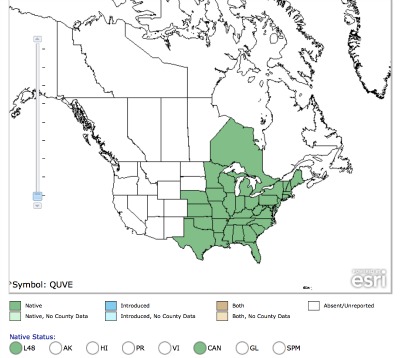
To analyze climate change in the Midwest, researchers created a model of black oak potential habitat given climate change (Iverson et al. 2010). Researchers used the two different greenhouse gas emission scenarios for their models. The more extreme scenario (A1FI) assumes that fossil fuel use will remain elevated until 2050. The less severe (B2) scenario assumes reduced reliance on fossil fuels, resulting in lower emissions.
The Global Climate Models used were the Hadley CM3 Model and the Parallel Climate Model (PCM). The Hadley CM3 Model was used to create climate projections based on the high emissions scenarios, representing the most extreme warming case for the study. The PCM was used to create climate projections based on the lowest emissions scenario to represent the least amount of warming.
For tree species information, Forestry Inventory and Analysis data was used to look at habitat characteristics for existing oak stands. To statistically model current species abundance in relation to the environment, 38 environmental variables (7 climate, 9 soil classes, 12 soil characteristics, 5 landscape and fragmentation variables, and 5 elevation variables) were used in a model known as the DISTRIB model.
The DISTRIB model does not consider biological or disturbance factors that influence species distributions. After a literature review, researchers came up with 9 biological and 12 disturbance modification factors (MODFAC) that influence oak regeneration, seeding survival, and longevity. They incorporated these factors into the original DISTRIB model. These factors considered species’ responses to disturbances such as drought, disease, fire, invasive species, temperature, and floods.
To determine the migration potential of a species in the next 100 years, researchers developed a model known as SHIFT. This model calculates colonization potential depending on:
• Abundance of species
• Distances between current habitat and potential habitat
• Quality of habitat
• Fragmented nature of landscape
The outputs from DISTRIB, MODFAC, and SHIFT are combined for more precise prediction.
Northward Migration Predicted
Climate change will likely affect habitats of wildlife due to increase in temperature, precipitation, invasive plants, pests and diseases. Black oak (Q. velutina) could gradually migrate northwards and to higher elevations, while being replaced by white oaks and other plants. Increases in temperature will cause more frequent and hotter fires that can inhibit black oak resurgence and survival. Black oak may be affected by diseases and successive defoliations by gypsy moth.
Conservation efforts can help preserve and increase the current population of black oaks. Red-headed woodpecker survival may be affected in a habitat without a mix of trees (black oaks) and grassland.
The use of this method of modeling is useful for land managers and land owners who must address an uncertain future given various climate change scenarios. While this approach may not apply to every ecosystem, it does highlight some variables that should be considered when modeling for climate change, such as changes in natural disturbance regimes, ecosystem components of current habitat, and habitat fragmentation.
Such modeling techniques can help provide guidance as to what components of a given ecosystem or area will be most impacted by changes in temperature and precipitation. It can also help with monitoring plans as it can help identify what ecosystem variables should be monitored, such as specific invasive species, fire frequency and intensity, when considering how the black oaks will change in distribution as climate changes.
Additional information about climate associated shifts in tree species and maps showing current suitable habitat maps and future habitat maps can be found in the Atlas of Climate Change Risk.
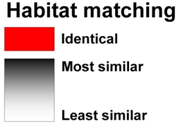
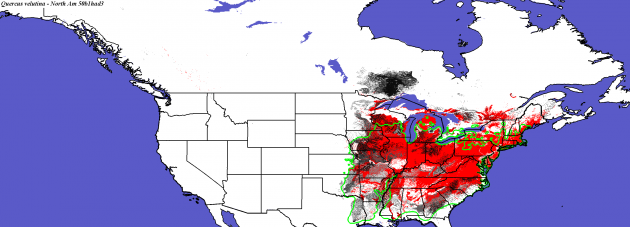
For additional information see:
- Oak Barrens – Michigan State University
- Oak Savannas of the Savanna Oak Foundation and Pleasant Valley Conservancy
- American Midwest is Last Oak Savanna Site – part six in a series on the National Science Foundation’s Long-Term Ecological Research (LTER) Network
~~~
Written by James Theuri, University of Illinois
REFERENCES CITED
Easterling, D.R. and Karl, T.R. 2001. www.usgcrp.gov/usgcrp/nacc/midwest.htm
Considine, C.D. 2009. Fire History and current stand structure analysis of a Midwestern black oak sand savanna. MS Thesis, Southern Illinois University, Carbondale. 96 pp.
Anderson, R.C. & Bowles, M.L. 1999. Deep-soil savannas and barrens of the midwestern United States. Pages 155-170 in: R.C. Anderson, J.E. Fralish, & Jerry Baskin (eds). The savanna, barren, and rock outcrop communities of North America. Cambridge University Press.
Nuzzo, V. 1986. Extent and status of Midwest oak savanna: pre-settlement and 1985. Natural Areas Journal 6, 6-36.
The Nature Conservancy update. 2011. http://www.nature.org/ourinitiatives/regions/northamerica/unitedstates/i…
Prasad, A., Iverson, L.S., Matthews, S. Peters, M. 2009. Atlases of tree and bird species habitats for current and future climates. Ecological Restoration 27:3, 260-263.
Prasad, A.M & Iverson, L.R. 1997. Modeling Tree Distributions in Eastern United States Using ArcInfo GIS and S-PLUS Statistical Package. In: http://proceedings.esri.com/library/userconf/proc97/proc97/to200/pap200/…
Iverson, L.R., Prasad, A.M., Matthews, S.N. & Peters, M.P. 2009. Potential changes in tree habitat for Illinois under climate change. In: Taft, John B., ed. Canaries in the catbird seat. Special Publication 30. Champaign, IL: Illinois Natural History Survey: 263-270.
U.S Global Change Research Program.Overview of Climate Change in Midwest: United States Global Change Research Program. http://www.globalchange.gov/publications/reports/scientific-assessments/…
Iverson, L.R., Prasad, A.M., Matthews, S.N., Peters, M.P. 2010. Merger of three modeling approaches to assess potential effects of climate change on trees in the eastern USA. In: Azevedo, Joao Carlos; Feliciano, Manuel; Castro, Jose; Pinto, Maria Alice, eds. Forest landscapes and global change-new frontiers in management, conservation and restoration. Proceedings of the IUFRO Landscape Ecology Working Group International Conference; 2010 September 21-27; Braganca, Portugal: 135-140.
Iverson, L.R., Schwartz, M.W. & Prasad, A.M. 2004. Potential colonization of newly available tree-species habitat under climate change: an analysis for five eastern US species. Landscape Ecology 19: 787–799.
Hargrove, W.W.; Hoffman, F.M. 2000. An analytical assessment tool for predicting changes in a species distribution map following changes in environmental conditions. In: 4th International Conference on Integrating GIS and Environmental Modeling (GIS/EM4): Problems, Prospects and Research Needs, Banff, Alberta, Canada, Sept. 2-8, 2000.
